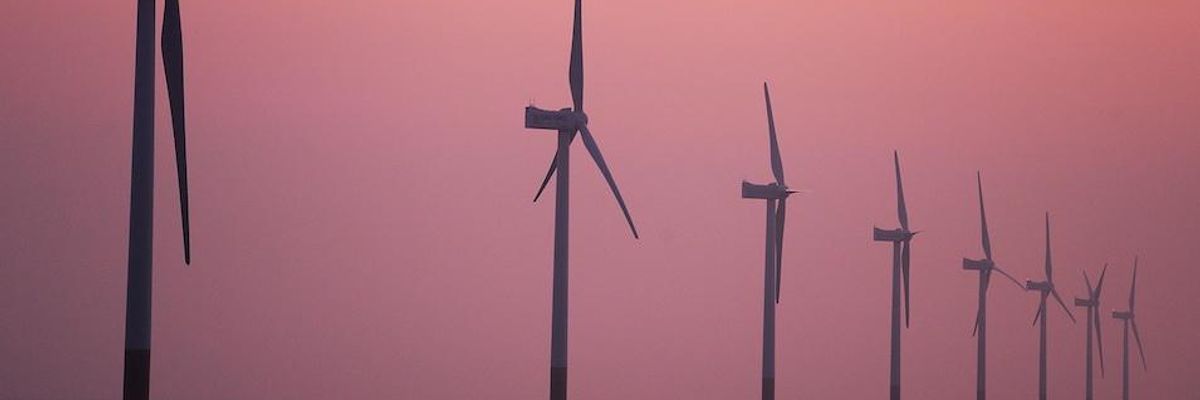

SUBSCRIBE TO OUR FREE NEWSLETTER
Daily news & progressive opinion—funded by the people, not the corporations—delivered straight to your inbox.
5
#000000
#FFFFFF
To donate by check, phone, or other method, see our More Ways to Give page.


Daily news & progressive opinion—funded by the people, not the corporations—delivered straight to your inbox.

Shanghai Donghai Bridge's 100mw offshore wind power project is China's first national offshore wind power demonstration project in the early morning light of morning in Shanghai, Oct. 4, 2019. (Photo: Costfoto/Barcroft Media/Barcroft Media/Getty Images)
A new report from the International Energy Agency released Friday claims that wind power could be a $1 trillion business by 2040 and that the power provided by the green technology has the potential to outstrip global energy needs.
"Talk about a breath of fresh air," tweeted writer Steven E. de Souza.
\u201cTalk about a breath of fresh air https://t.co/r2a0bvMXBc\u201d— Steven E. de Souza (@Steven E. de Souza) 1571985817
The IEA report looks at the business of wind power and opines that as investment increases and the technology becomes cheaper, the sector could explode.
The IEA finds that global offshore wind capacity may increase 15-fold and attract around $1 trillion of cumulative investment by 2040. This is driven by falling costs, supportive government policies and some remarkable technological progress, such as larger turbines and floating foundations. That's just the start--the IEA report finds that offshore wind technology has the potential to grow far more strongly with stepped-up support from policy makers.
"Offshore wind currently provides just 0.3% of global power generation, but its potential is vast," said IEA executive director Fatih Birol.
It would take a major infrastructural commitment to develop wind power to the point that the renewable energy resource could take over the majority of global energy needs, but it's not impossible. As The Guardianpointed out Friday, "if windfarms were built across all useable sites which are no further than 60km (37 miles) off the coast, and where coastal waters are no deeper than 60 metres, they could generate 36,000 terawatt hours of renewable electricity a year."
"This would easily meeting the current global demand for electricity of 23,000 terawatt hours," added The Guardian.
Such a change in worldwide energy demand would require a massive investment of "public pressure, business leadership, and political leadership," green group Friends of the Earth said on Twitter.
350 Action founder Bill McKibben saw no need to wait.
"Wind turbines in the shallow parts of the planet's oceans can provide more electricity than the planet uses," McKibben tweeted. "So let's get going!"
Trump and Musk are on an unconstitutional rampage, aiming for virtually every corner of the federal government. These two right-wing billionaires are targeting nurses, scientists, teachers, daycare providers, judges, veterans, air traffic controllers, and nuclear safety inspectors. No one is safe. The food stamps program, Social Security, Medicare, and Medicaid are next. It’s an unprecedented disaster and a five-alarm fire, but there will be a reckoning. The people did not vote for this. The American people do not want this dystopian hellscape that hides behind claims of “efficiency.” Still, in reality, it is all a giveaway to corporate interests and the libertarian dreams of far-right oligarchs like Musk. Common Dreams is playing a vital role by reporting day and night on this orgy of corruption and greed, as well as what everyday people can do to organize and fight back. As a people-powered nonprofit news outlet, we cover issues the corporate media never will, but we can only continue with our readers’ support. |
A new report from the International Energy Agency released Friday claims that wind power could be a $1 trillion business by 2040 and that the power provided by the green technology has the potential to outstrip global energy needs.
"Talk about a breath of fresh air," tweeted writer Steven E. de Souza.
\u201cTalk about a breath of fresh air https://t.co/r2a0bvMXBc\u201d— Steven E. de Souza (@Steven E. de Souza) 1571985817
The IEA report looks at the business of wind power and opines that as investment increases and the technology becomes cheaper, the sector could explode.
The IEA finds that global offshore wind capacity may increase 15-fold and attract around $1 trillion of cumulative investment by 2040. This is driven by falling costs, supportive government policies and some remarkable technological progress, such as larger turbines and floating foundations. That's just the start--the IEA report finds that offshore wind technology has the potential to grow far more strongly with stepped-up support from policy makers.
"Offshore wind currently provides just 0.3% of global power generation, but its potential is vast," said IEA executive director Fatih Birol.
It would take a major infrastructural commitment to develop wind power to the point that the renewable energy resource could take over the majority of global energy needs, but it's not impossible. As The Guardianpointed out Friday, "if windfarms were built across all useable sites which are no further than 60km (37 miles) off the coast, and where coastal waters are no deeper than 60 metres, they could generate 36,000 terawatt hours of renewable electricity a year."
"This would easily meeting the current global demand for electricity of 23,000 terawatt hours," added The Guardian.
Such a change in worldwide energy demand would require a massive investment of "public pressure, business leadership, and political leadership," green group Friends of the Earth said on Twitter.
350 Action founder Bill McKibben saw no need to wait.
"Wind turbines in the shallow parts of the planet's oceans can provide more electricity than the planet uses," McKibben tweeted. "So let's get going!"
A new report from the International Energy Agency released Friday claims that wind power could be a $1 trillion business by 2040 and that the power provided by the green technology has the potential to outstrip global energy needs.
"Talk about a breath of fresh air," tweeted writer Steven E. de Souza.
\u201cTalk about a breath of fresh air https://t.co/r2a0bvMXBc\u201d— Steven E. de Souza (@Steven E. de Souza) 1571985817
The IEA report looks at the business of wind power and opines that as investment increases and the technology becomes cheaper, the sector could explode.
The IEA finds that global offshore wind capacity may increase 15-fold and attract around $1 trillion of cumulative investment by 2040. This is driven by falling costs, supportive government policies and some remarkable technological progress, such as larger turbines and floating foundations. That's just the start--the IEA report finds that offshore wind technology has the potential to grow far more strongly with stepped-up support from policy makers.
"Offshore wind currently provides just 0.3% of global power generation, but its potential is vast," said IEA executive director Fatih Birol.
It would take a major infrastructural commitment to develop wind power to the point that the renewable energy resource could take over the majority of global energy needs, but it's not impossible. As The Guardianpointed out Friday, "if windfarms were built across all useable sites which are no further than 60km (37 miles) off the coast, and where coastal waters are no deeper than 60 metres, they could generate 36,000 terawatt hours of renewable electricity a year."
"This would easily meeting the current global demand for electricity of 23,000 terawatt hours," added The Guardian.
Such a change in worldwide energy demand would require a massive investment of "public pressure, business leadership, and political leadership," green group Friends of the Earth said on Twitter.
350 Action founder Bill McKibben saw no need to wait.
"Wind turbines in the shallow parts of the planet's oceans can provide more electricity than the planet uses," McKibben tweeted. "So let's get going!"